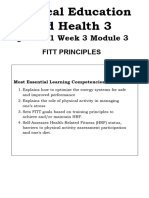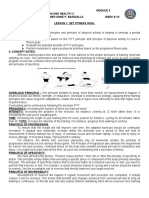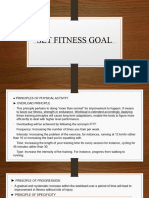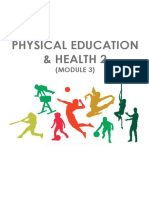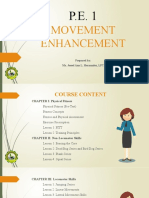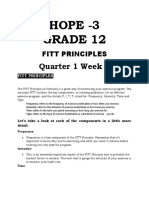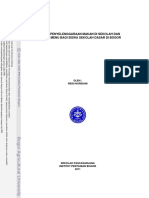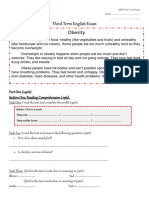Bicol University
Institute of Physical Education, Sports and Recreation
Legazpi City
Email Address: buipesr@gmail.com
Training Principles
I. LEARNING OUTCOMES:
Objectives:
Explain how the FITT principle helps build fitness
At
the end ofthethis
Identify lesson,training
different you should be able to:
principles
Topics/Subtopics
Lesson 5: FIIT Principles
Lesson 6: Training Principles
II. LEARNING CONTENT:
LESSON 5: FITT PRINCIPLE
Frequency of Exercise - It refers to how often you do physical activity. The number of days per week
dedicated to an exercise program. The frequency of physical activity is an important contributor to
health/fitness benefits that result from exercise. For physical activity to be beneficial you, you must do it
several days a week. Frequency depends on the type of physical activity you are doing and the part of
fitness you want to develop.
Intensity of Exercise - It refers to how hard you exercise. Fitness benefits occur when a person exercises
harder than his or her normal level of activity. If the activity you do is too easy, you will not build fitness
and gain other benefits. The appropriate exercise intensity varies with each fitness component. To
develop cardiorespiratory endurance, for example, you must raise your heart rate above normal. To
develop muscular strength, you must lift a heavier weight than normal. To develop flexibility, you must
stretch muscles beyond their normal length.
Time - It refers to how long you do physical activity. Fitness benefits occur when you exercise for an
extended period of time. The length of time you should do physical activity depends on the type of
activity and the part of fitness you want to develop. For cardiorespiratory endurance exercise, 20–60
minutes per exercise session is recommended. Exercise can take place in a single session or in several
sessions of 10 or more minutes. The greater the intensity of exercise, the less time needed to obtain fitness
benefits. For high-intensity exercise, such as running, 20–30 minutes is appropriate. For moderate-
intensity exercise, such as walking, 45–60 minutes may be needed. High-intensity exercise poses a greater
risk of injury than low-intensity exercise, so if you are a nonathletic adult, it’s best to first emphasize low-
to moderate-intensity activity of longer duration. To build muscular strength, muscular endurance, and
flexibility, similar amounts of time are advisable, but training for these health components is more
commonly organized in terms of a specific number of repetitions of a particular exercise. For resistance
training, for example, a recommended program includes one or more sets of 8–12 repetitions.
Type - It refers to the kind of activity you do to build a specific part of fitness or to gain a specific
benefit. To develop cardiorespiratory endurance, you need to engage in continuous activities involving
large-muscle groups—walking, jogging, cycling, or swimming, for example. Resistance exercises
develop muscular strength and endurance, and stretching exercises build flexibility. The frequency,
intensity, and time of the exercise will be different for each type of activity.
Page 1 of 2
�LESSON 5: FITT PRINCIPLE
Essential within the FITT framework are the following principles of training that must be
considered when training for cardiorespiratory, resistance and flexibility exercise:
Principle of Overload. The most basic law of physical activity that’s states the only way to produce
fitness and health benefits through physical activity is to require your body to do more than it normally
does. An increased demand on your body forces it to adapt. Overload can be achieved through increases
in the frequency, intensity, and duration of exercise. Muscle groups can be effectively overloaded through
increases in the number of repetitions, sets, or exercises in programs that improve muscular fitness and
flexibility.
Principle of progression. Throughout the training program, you must progressively increase the training
volume, or overload, to stimulate further improvements (i.e., progression principle). The progression
needs to be gradual because doing too much, too soon may cause injuries which is a major reason why
some individuals drop out of exercise programs. After a while your body will adapt to an increase in
physical activity and becomes easy. When this happens, you should increase workload.
Principle of Specificity. The specificity principle states that the body’s physiological and metabolic
responses and adaptations to exercise training are specific to the type of exercise and the muscle groups
involved. For example, physical activities requiring continuous, dynamic, and rhythmical contractions of
large muscle groups are best suited for stimulating improvements in cardiorespiratory endurance;
stretching exercises develop range of joint motion and flexibility; and resistance exercises are effective
for improving muscular strength and muscular endurance. Furthermore, the gains in muscular fitness are
specific to the exercised muscle groups, type and speed of contraction, and training intensity.
Principle of Reversibility. The positive physiological effects and health benefits of regular physical
activity and exercise are reversible. When individuals discontinue their exercise programs (detraining),
exercise capacity diminishes quickly. Within a few months, most of the training improvements are lost
Principle of Individuality. Individual responses to a training stimulus are quite variable and depend on a
number of factors such as age, initial fitness level, and health status. You therefore must design exercise
programs with the specific needs, interests, and abilities of each client in mind and develop personalized
exercise prescriptions that take into account individual differences and preferences.
III. LEARNING ACTIVITY:
Check your progress
1. How does the FITT Formula help you build physical fitness?
2. What are the training principles?
3. How can you use the training principles to begin planning a physical activity program?
IV. LEARNING REFERENCE:
Corbin, Charles & Lindsey, Ruth. (2005). Fitness for Life, 5th ed. Human Kinetics
Fahey D. et al.(2017).Fit & Well: Core Concepts and Labs in Physical Fitness and Wellness, Brief Edition,12 th
Edition. McGraw-Hill Education
Page 2 of 2






